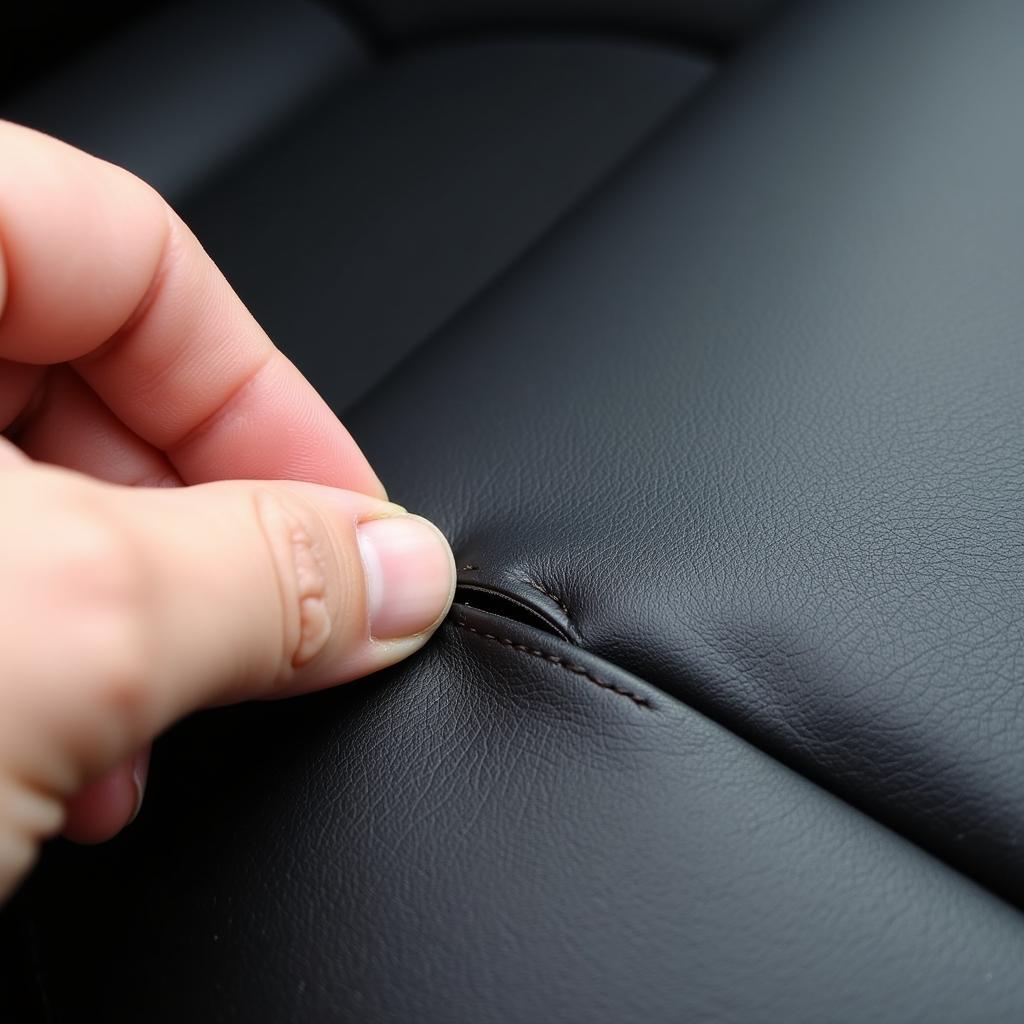Torn car seats are an unfortunate reality for many car owners. Whether it’s from general wear and tear, sharp objects, or rambunctious pets, a tear can quickly diminish the appearance and value of your vehicle’s interior. Fortunately, you don’t necessarily need to replace the entire seat. Learning how to repair torn car seats can save you money and restore your car’s interior to its former glory. This guide will provide you with effective methods and tips for repairing various types of car seat damage.
This comprehensive guide covers everything from minor scuffs to larger tears, offering solutions for both leather and fabric upholstery. We’ll explore different repair techniques, from DIY fixes using readily available materials to more advanced methods that might require specialized tools or professional assistance. You’ll learn how to assess the damage, choose the right repair kit, and execute the repair effectively. Whether you’re dealing with a small snag or a significant rip, this guide will empower you to tackle the repair process with confidence.
Assessing the Damage: The First Step in Car Seat Repair
Before you begin any repair, it’s crucial to assess the extent of the damage. Is it a small puncture, a rip along a seam, or a large tear? The type and size of the damage will determine the appropriate repair method. For small nicks and scratches, a simple leather or vinyl repair kit might suffice. However, larger tears might require patching, stitching, or even professional upholstery repair.
Repairing Tears in Fabric Car Seats
Fabric car seats are prone to snags, tears, and burns. Repairing these often involves patching the damaged area with a matching fabric or using a specialized fabric repair kit. These kits typically include adhesive patches, fabric glue, and color-matching compounds. For small holes or burns, you can use a liquid fabric repair compound to fill the damaged area and blend it seamlessly with the surrounding fabric. For larger tears, a patch is usually the best solution.
How to Patch a Tear in a Fabric Car Seat
Patching involves applying a piece of matching fabric to the underside of the tear and securing it with adhesive. It’s essential to choose a fabric that closely matches the original upholstery in color and texture. Carefully cut the patch to size, ensuring it’s slightly larger than the tear. Apply the adhesive to the patch and carefully position it under the tear. Smooth out any wrinkles and allow the adhesive to dry completely.
Repairing Tears in Leather Car Seats
Leather car seats, while durable, can also suffer from tears and cracks. Repairing leather requires a different approach than fabric. Leather repair kits are specifically designed to address the unique characteristics of leather. These kits often include a leather filler compound, color-matching pigments, and a grain paper to replicate the original leather texture. For small cracks and tears, you can use the filler compound to fill the damaged area and then blend it with the surrounding leather.
how to repair torn car seat fabric
Addressing Larger Tears in Leather: Patching and Professional Repair
Larger tears in leather car seats might require more extensive repair methods, such as patching or professional upholstery work. Patching leather is similar to patching fabric but requires specialized leather adhesive and a matching leather patch. If the tear is significant or in a prominent location, professional upholstery repair is often the best option. A skilled upholsterer can restore the leather to its original condition, ensuring a seamless and durable repair.
Best Practices for Torn Car Seat Repair
Regardless of the material or the repair method, several best practices can help ensure a successful and long-lasting repair. Always clean the area thoroughly before applying any repair materials. Use high-quality repair kits designed for the specific material of your car seat. Follow the instructions carefully and allow ample drying time for adhesives and fillers.
best way to repair torn leather car seat
Preventing Future Tears
Once you’ve repaired your car seat, take steps to prevent future damage. Use seat covers to protect the upholstery from wear and tear. Avoid sharp objects and be mindful of pets or children that might cause damage. Regular cleaning and conditioning can also help maintain the integrity of the leather or fabric.
Conclusion: Maintaining the Integrity of Your Car’s Interior
Learning how to repair torn car seats is a valuable skill for any car owner. By addressing tears promptly and using the appropriate repair techniques, you can maintain the appearance and value of your vehicle’s interior. Remember to assess the damage carefully, choose the right repair materials, and follow the instructions diligently. Whether you opt for a DIY fix or professional repair, taking care of your car seats will ensure a comfortable and aesthetically pleasing driving experience.
FAQ
-
What’s the best way to repair a small tear in a leather car seat?
A leather repair kit is typically the best solution for small tears. -
Can I repair a burn hole in a fabric car seat?
Yes, you can use a liquid fabric repair compound to fill the burn hole. -
When should I consider professional upholstery repair?
For significant tears or damage in prominent locations, professional repair is often the best option. -
How can I prevent future tears in my car seats?
Using seat covers and avoiding sharp objects are effective preventive measures. -
Where can I find matching fabric for patching a tear?
You can often find matching fabric at fabric stores or online retailers specializing in automotive upholstery. -
What type of adhesive should I use for leather repair?
Use a specialized leather adhesive designed for automotive upholstery. -
How long does it take for leather filler to dry?
Drying times vary depending on the product, so refer to the manufacturer’s instructions.
Common Scenarios and Questions:
-
Scenario: My dog scratched my leather car seat, leaving a noticeable mark.
- Question: Can I repair this myself, or should I consult a professional?
-
Scenario: The seam on my fabric car seat has started to unravel.
- Question: How can I repair the seam without replacing the entire seat cover?
-
Scenario: I spilled bleach on my car seat, causing discoloration.
- Question: Is there a way to restore the original color or camouflage the stain?
Related Articles and Resources
You may also find these helpful:
- How to Clean Car Seats
- Best Car Seat Covers for Protection
- DIY Car Upholstery Cleaning Tips
For immediate assistance, please contact us via WhatsApp: +1(641)206-8880 or Email: cardiagtechworkshop@gmail.com. Our customer support team is available 24/7.



